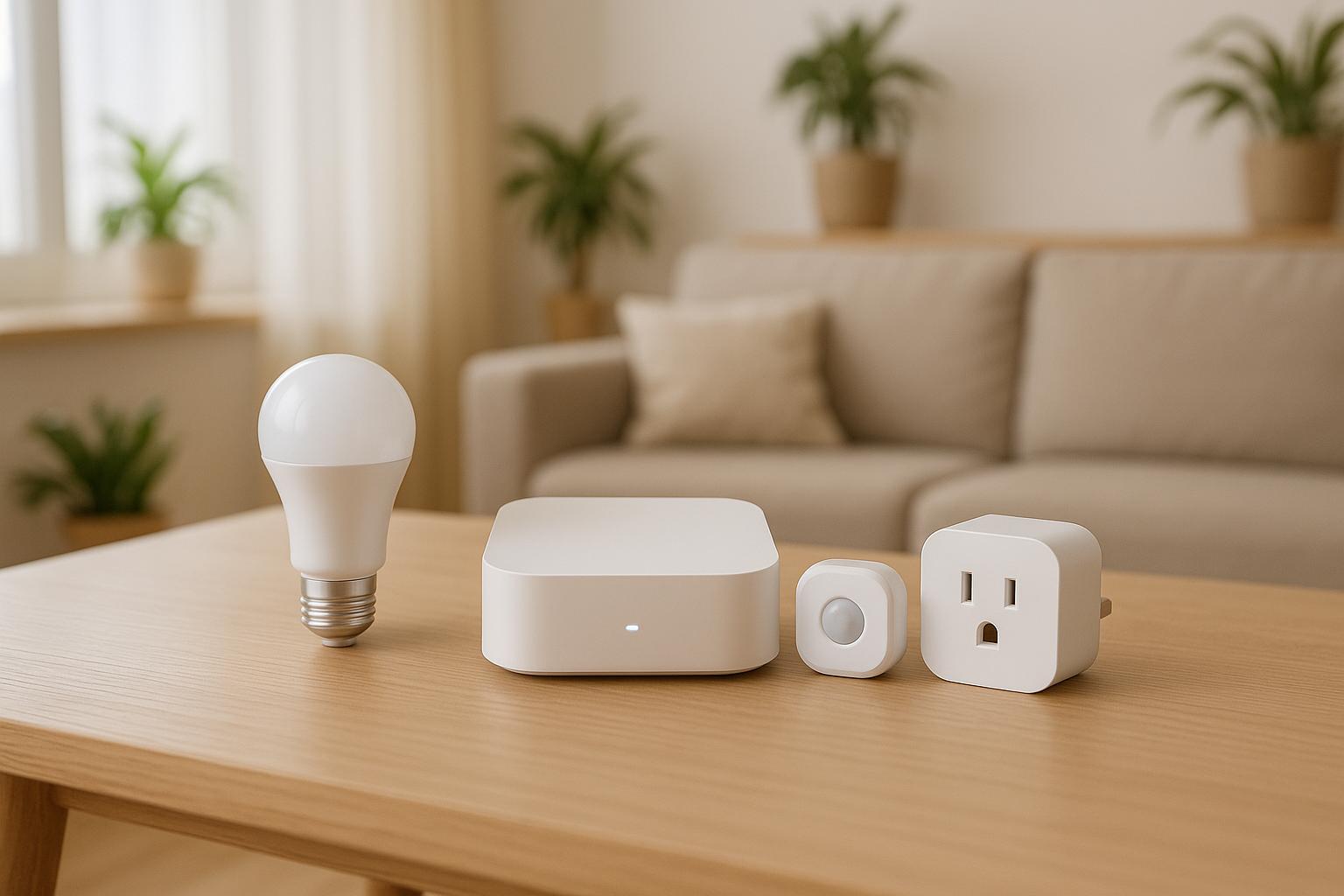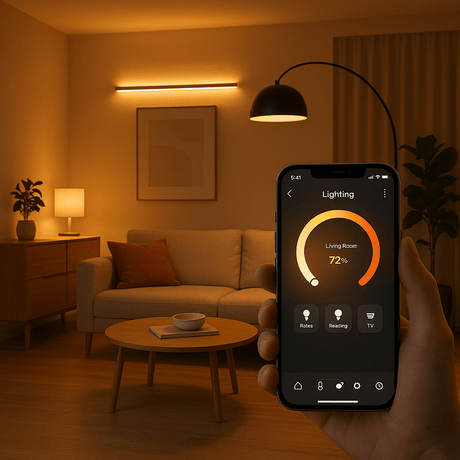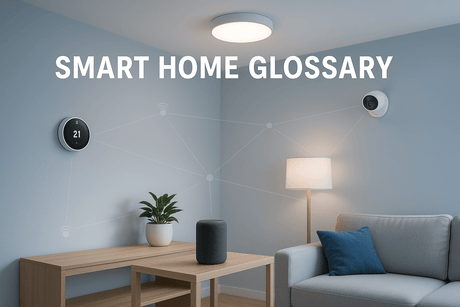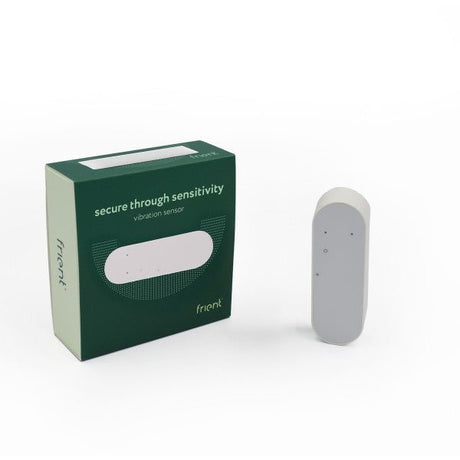Want a reliable smart home? Start with Zigbee. Zigbee is a wireless protocol perfect for smart homes, offering low power use, a self-healing mesh network, and support for up to 65,000 devices. Here's how you can set up your Zigbee system in just a few steps:
- Start with a Hub (Coordinator): Acts as the brain of your network. Place it centrally, connect it to power and your router, and set it up via the app.
- Add Routers: Devices like smart plugs and bulbs that strengthen your network. Position them within 10 metres of the hub during setup.
- Connect End Devices: Battery-powered sensors (e.g., motion, door) that rely on the network for communication.
- Optimise Placement: Spread router devices evenly to ensure solid coverage across your home.
Why Zigbee?
- Secure: 128-bit AES encryption.
- Efficient: Devices can last up to 10 years on batteries.
- Flexible: Compatible with brands like Philips, Samsung, and Amazon.
Quick Tip: For larger homes, add Zigbee repeaters to extend coverage. Once connected, you can automate routines like lighting, security, and voice control via Alexa or Google Assistant.
Zigbee makes smart home automation simple, efficient, and scalable. Ready to get started? Read on for a step-by-step guide.
Required Zigbee System Components
Setting up a Zigbee smart home system involves three main components. Understanding these will help you design a dependable and efficient network tailored to your automation needs.
Choosing a Hub
The hub, or Zigbee coordinator (ZC), is the brain of your system. It sets up your network, ensures secure communication with 128-bit AES encryption, and manages interactions between connected devices.
When picking a hub, look for these key features:
| Feature | Importance |
|---|---|
| Device Capacity | Can handle up to 65,000 devices, ideal for scalability |
| Power Supply | Requires constant 230V mains power for uninterrupted operation |
| App Integration | Allows remote control and personalised automation |
| Voice Assistant Support | Works with Alexa and Google Home for added convenience |
An example of a reliable option is the Zignito Smart Zigbee Hub, rated 4.84 out of 5 by 93 customers. At £40.00, it supports up to 128 devices, which is more than sufficient for most UK households.
Once your hub is sorted, it’s essential to understand the types of devices that will form your Zigbee network.
Network Device Types
Your Zigbee system includes two additional types of devices:
-
Zigbee Routers (ZR): These mains-powered devices create the mesh network, ensuring strong connectivity. Examples include:
- Smart light bulbs
- Plug sockets
- Light switches
- Appliance modules
- Zigbee End Devices (ZED): Battery-powered sensors that rely on routers or the hub for communication. Examples include:
Technical Requirements
For a smooth setup in UK homes, make sure your system meets these guidelines:
- Network Coverage: Position the hub centrally for optimal signal strength.
- Device Compatibility: Choose devices certified with Zigbee 3.0 for seamless integration.
Keep the hub powered continuously and place it away from metal objects or thick walls to avoid signal interference.
Setting Up Your Zigbee Network
Now that you’re familiar with the key components, let’s dive into the practical steps for setting up your Zigbee smart home system.
Hub Installation
Start by placing your Zigbee hub in a central location, ideally within 10 metres of your main devices. Avoid positioning it near thick walls or metal objects, as these can interfere with the signal.
Here’s how to get your hub up and running:
-
Power and Internet Connection
Plug your hub into a stable power source (most UK models run on 230V mains). Use an ethernet cable to connect the hub directly to your router for the best connection reliability. -
App Setup
Download the app provided by the hub’s manufacturer, create an account, and follow the setup wizard. Make sure your smartphone is connected to a 2.4GHz Wi-Fi network during this process. If the pairing process doesn’t work, press and hold the hub's reset button for 10 seconds until its indicator light flashes orange.
Once your hub is powered and connected, you can move on to pairing your devices.
Device Pairing
Building a strong Zigbee network requires a bit of strategy. Begin by connecting router devices, as they form the backbone of your mesh network. Once those are in place, you can add battery-powered end devices.
Connecting Router Devices
Position each router device within 5 metres of the hub during setup. Open the app to enable pairing, then follow the factory reset instructions in the device manual. Once the app confirms the connection, you’re good to go.
Adding End Devices
After setting up the routers, you can connect end devices like sensors and switches. Here’s a quick guide:
| Device Type | Pairing Method | Success Indicator |
|---|---|---|
| Smart Bulbs | Power cycle 5 times | Flashing light |
| Sensors | Press pair button 4 times | LED blink |
| Switches | Hold button for 5 seconds | Status light change |
Device Management
After pairing, it’s time to organise and manage your devices for smooth operation.
Use the Zignito Smart hub app to group devices by room, assign custom names for easy identification, and adjust settings to suit your preferences. The app also lets you monitor battery levels for end devices so you can replace them before they run out.
Keep your network running smoothly by regularly checking device connectivity, updating firmware, ensuring router devices stay powered, and keeping an eye on battery levels.
Network Setup and Automation
Network Range
Getting strong connectivity across your home starts with smart placement of your devices. For the best results, position mains-powered router devices about 10 metres apart. This helps create a reliable mesh network, which is ideal for the layout of a typical UK semi-detached house.
If you’re dealing with weak signals in certain spots, try these fixes:
- Use a USB extension cable to move your hub away from Wi-Fi routers and metal objects that might interfere with the signal.
- Switch your Zigbee network to a less crowded channel, like channel 11.
- Add a Zigbee router, such as the IKEA Tradfri Signal Repeater, to boost coverage in problem areas.
For larger homes (over 100 square metres), place router devices strategically to maintain strong connectivity. Here’s a quick guide to placement:
| Location | Purpose | Coverage Range |
|---|---|---|
| Hallways | Central distribution | 10–15 metres |
| Stairwells | Multi-floor coverage | 5–10 metres per floor |
| Living spaces | High-traffic areas | 10–30 metres |
Once your network is solid, you can start setting up automations to make daily life more convenient.
Setting Up Automations
- Sunset Lighting Automatically turn on your outdoor lights at sunset. Indoors, set your lights to dim to 50% brightness and switch to a warm white tone (around 2700K) to create a snug, welcoming vibe.
- Security Measures Use motion sensors to activate pathway lights between 18:00 and 23:00. When motion is detected, the lights will come on for a few minutes before turning off again, helping you save energy while keeping your home secure.
- Bedtime Sequence Set up a "Goodnight" routine that gradually dims all the lights in your home over 30 minutes. This can also ensure that non-essential devices are powered down for the night.
Once your automations are in place, you can make things even easier by adding voice control.
Voice Control Setup
Position your Echo device within 9 metres of your Zigbee devices for the best performance.
To set it up, open the Alexa app and go to 'Devices' > '+' > 'Add Device', then select 'Other > Zigbee'.
- Follow the manufacturer’s instructions to put your device into pairing mode.
- Wait for Alexa to detect and configure the device.
To make voice commands seamless, give your devices straightforward, easy-to-remember names like "Kitchen Spots" or "Bedroom Lamp." This way, Alexa will have no trouble recognising your commands.
Problem Solving and Upkeep
Connection Problems
Zigbee devices can sometimes lose connection due to interference or physical barriers like brick walls. To improve connectivity, try placing devices closer to the hub or a mains-powered router within your mesh network.
You can also minimise interference by:
- Using a USB extension to adjust the coordinator's position
- Changing your Wi-Fi channel to 1, 6, or 11
- Keeping the hub away from smart meters
If the connection remains unstable, consider power cycling the network for about 30 minutes to help restore stability.
Battery Care
Maintaining your battery-powered sensors is just as important as managing connectivity. Most sensors use CR2032 batteries, which typically last between 12 and 24 months. To get the most out of your batteries:
- Regularly check battery levels through your hub's interface
- Replace batteries promptly when performance starts to dip
- Stick to high-quality batteries from trusted brands
For outdoor sensors, it's a good idea to use weatherproof housing to shield them from moisture and the unpredictable British weather.
System Updates
Keeping your Zigbee devices updated ensures a stable and efficient network. Many modern hubs support over-the-air (OTA) firmware updates, simplifying the process.
To update smoothly:
- Make sure all devices are powered and within range
- Schedule updates during quieter times to reduce network strain
- Avoid interrupting the update process
- Verify that all devices reconnect successfully afterwards
If a device struggles to update, try moving it closer to the hub during the process. Keeping a log of updates and battery replacements can also be helpful for tracking performance and planning future maintenance. These steps will help keep your Zigbee system running smoothly.
Summary
Now that you've completed the setup process, let's recap the essentials for building a reliable Zigbee smart home system. Setting up your first Zigbee network is a simple process that brings practical benefits to your daily life. With its mesh networking technology, Zigbee can easily scale to meet the demands of an expanding smart home.
A well-thought-out Zigbee setup combines a centrally located hub with a mix of mains-powered and battery-operated devices. This creates a dependable wireless network. Placing devices strategically throughout your home ensures smooth performance, while the network's self-healing feature keeps connections stable.
"Simply put, Zigbee is a wireless protocol that is used to allow Smart Devices such as light bulbs, sockets, plugs, smart locks, motion sensors and door sensors to communicate with each other over a 'PAN' (Personal Area Network)." - Vesternet
Zigbee's compatibility makes it easy to expand your system with confidence. Regular updates, proper maintenance, and thoughtful router placement help the system perform over time. Plus, Zigbee's low power usage means battery-powered sensors only need occasional attention, adding to the network's overall efficiency.
FAQs
What makes Zigbee a better choice for smart home systems compared to other protocols?
Zigbee has earned its place as a dependable option for smart home systems thanks to its low power consumption, flexibility, and secure connections. It’s a fantastic choice for battery-operated devices like sensors, offering impressive battery life - sometimes lasting up to 10 years. Its mesh network structure is another big advantage, as it ensures strong coverage and reliability by allowing devices to pass signals between each other, even if one device stops working.
What’s more, Zigbee can handle thousands of devices on a single network, making it perfect for larger smart home setups. With 128-bit AES encryption, it provides a solid layer of security, and its user-friendly design makes setup straightforward, even for beginners. On top of that, many Zigbee devices are often more affordable than other options, making it an excellent choice for creating a smart home system that balances performance and cost.
How can I keep my Zigbee network stable and avoid interference?
To keep your Zigbee network running smoothly and minimise interference, here are some practical tips to consider:
- Place your coordinator wisely: Position it in a central spot in your home, away from walls, electronic gadgets, and interference sources like Wi-Fi routers or Bluetooth devices. This helps ensure better signal coverage.
- Use a USB extension cable: If your coordinator connects via USB, a shielded extension cable can help position it further from potential interference sources, improving its performance.
- Pick the right Zigbee channel: Choose a channel that avoids overlapping with your Wi-Fi network to prevent signal conflicts.
- Add mains-powered devices: These devices double as Zigbee routers, enhancing both the range and stability of your network.
- Update firmware regularly: Keeping your coordinator’s firmware up to date ensures compatibility and can improve overall performance.
By implementing these tips, you can enjoy a reliable and interference-free Zigbee network for your smart home setup.
What can I do if my Zigbee devices keep disconnecting or have weak signals?
If your Zigbee devices keep disconnecting or struggle with weak signals, don’t worry - there are a few practical steps you can try to fix the issue:
- Restart the device: Often, simply turning the device off and back on can resolve connectivity problems. It’s quick and worth a try.
- Optimise your hub's location: Place your Zigbee hub or coordinator in a central spot in your home. Keep it away from other electronics that might cause interference. If your hub is connected to a computer or Raspberry Pi, using a USB extension cable can help reduce signal disruption.
- Reduce interference: Zigbee runs on the 2.4 GHz frequency, which is also used by Wi-Fi routers and other devices. To avoid conflicts, keep your Zigbee hub away from these devices. You can also adjust the Zigbee channel to minimise overlap with Wi-Fi signals.
- Boost your network: Adding mains-powered Zigbee devices like smart plugs can help. These devices act as repeaters, extending the network’s range and improving its stability.
Still having trouble? Check your device’s manual for specific troubleshooting tips or dive into your Zigbee hub’s settings for advanced configuration options.


















